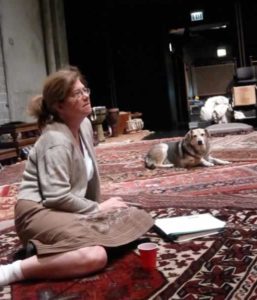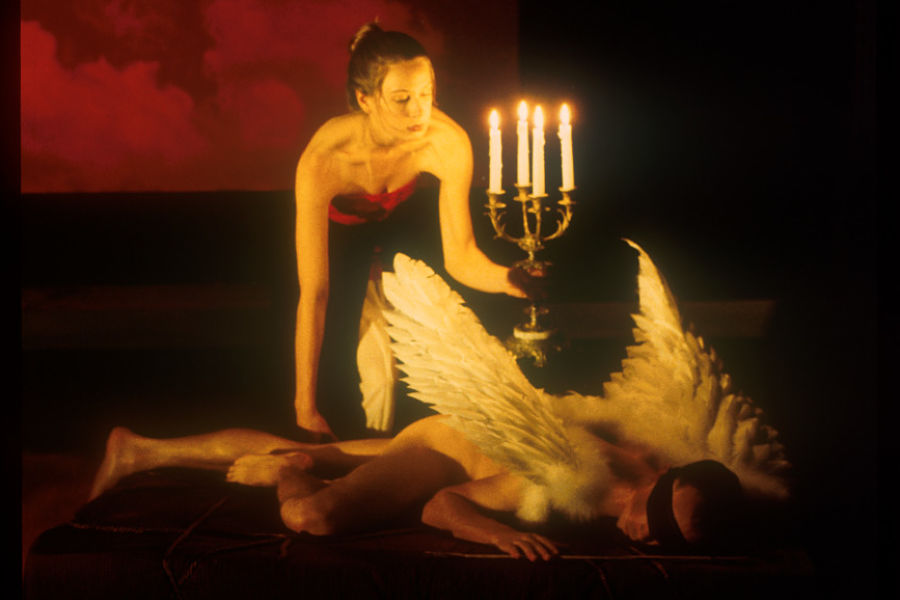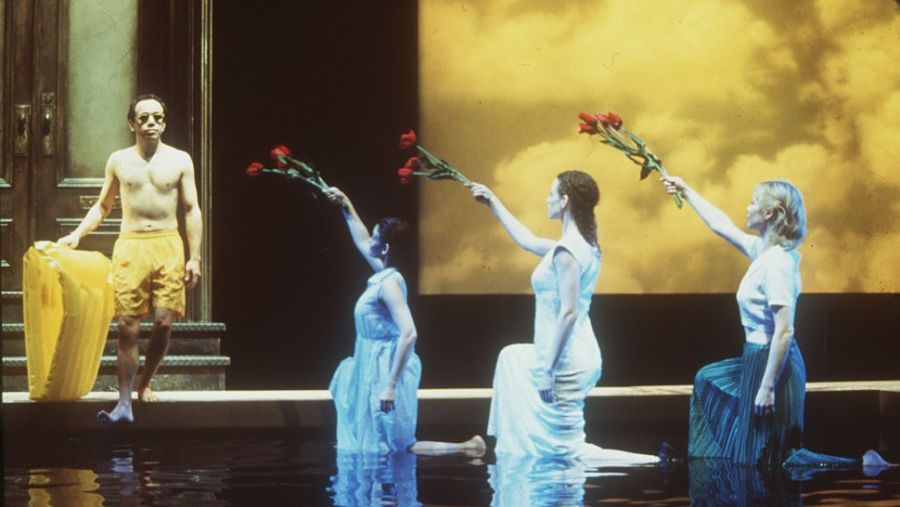The following is an excerpt from the new book Rise Up! Broadway and American Society from 'Angels in America' to 'Hamilton' by Chris Jones (published by Methuen Drama), theatre critic for the Chicago Tribune, in which he strives to situate major cultural trends of the last quarter century in their theatrical context, and vice versa. Other chapters cover the rise of Rent, the Disney-fication of Times Square, the persistence of the straight play on Broadway, the Spider-Man debacle, and more.
Jed Bernstein, president of the Broadway League, had heard the mayor’s message coming through loud and clear: Reopen Broadway as fast as humanly possible.
Tuesday, Sept. 11, 2001, had dawned sunny, clear, and seemingly benign. Until, that is, 19 al-Qaeda terrorists hijacked four jet aircraft, two belonging to American Airlines and two belonging to United, quickly terrifying and murdering their unsuspecting passengers. One of those planes was then steered and crashed into the Pentagon in Washington, D.C.; one, following a brave onboard confrontation, would end up diving into the ground near Shanksville, Pa.; and, on this morning no American ever would forget, two would be sent careening into the Twin Towers of the World Trade Center in Manhattan.
Within two hours, the day would become among the most infamous in a nation’s history, forever to be known as 9/11, the digits to be dialed in case of a crisis transformed into a shorthand for a day of unspeakable horror.
In New York, the official death toll would reach 2,605 people, most of them people who had been working inside the Twin Towers, toiling above or on the floors where the planes hit, their workplaces soon falling to the earth, taking hundreds of human souls with them as they disappeared in a cloud of toxic dust.
Sept. 11, 2001, almost shattered the spirit of New York, and the country; in the days that immediately followed, when the skies over America’s great cities were eerily bereft of planes, it seemed that nothing ever would be the same, that the values of a great liberal democracy had been blown apart forever, that normalcy never would return, that life now involved living the unimaginable. On a national scale.
And aside from such macro concerns, the Broadway community was also faced with the most personal of crises. Almost everyone knew someone who had been impacted by the attack, and many knew someone who had been killed. TKTS, the half-price ticketing service, had maintained an outpost in the Twin Towers, although, given the early hour of the attacks, the counter was mercifully not yet open. But the site of the entire tragedy was just a long, stiff walk down one of New York’s majestic avenues from Times Square. It was plenty near enough that, on that Tuesday morning, disheveled human figures covered head-to-toe in gray dust could be seen wandering outside its theatres.
Broadway had gone dark on Sept. 11, just as an entire nation’s consciousness had gone dark.
Everything stopped.
But before long, as the pain and confusion raged on, it became clear to Mayor Rudolph Giuliani and Schuyler G. Chapin, his commissioner of cultural affairs, that something had to be done quickly to restore at least some sense of continuance to the city, to avert a potential economic crisis that might cost artists and technicians their jobs and, in doing so, declare that the terrorist attacks had not done permanent damage to what Alexander Hamilton, in a musical made some years later, would call “the greatest city in the world.” And so the word went out from city leadership to Bernstein at the League of American Theaters and Producers and then to the theatre owners: Reopen.
Preferably tonight.
Bernstein, who had seen members of Congress sing together on the steps of the Capitol in wounded Washington, D.C., went to work, suggesting to the running shows that they think about maybe ending the night with “God Bless America” or some other soul-stirring song that would acknowledge the extraordinary nature of the moment and the sense of collective accomplishment from both the performers and the audience. The TKTS booth by Times Square was instructed to reopen on Sept. 13, and reopen it did, to the relief of many of the tourists (and air crews) who had found themselves trapped in a city of grieving, unable to fly anywhere and wearied by their television screens playing constant reruns of death and destruction. Many could not have been happier to stand in line and go and see a show for half price.
Remarkably, on Thursday, Sept. 13, just 48 hours after the attacks, all 23 Broadway theatres were up and running. It was—by any historical standards—an extraordinary public and private achievement and a crucial cog in the wheel of the city’s recovery. Giuliani quickly expressed his thanks, announcing at a press conference that if anybody wanted to help New York, a really good way to do so would be to go and see a Broadway show.
On that night all those shows featured a moment of silence prior to the performance. And, as is traditional in times of loss, all of the Broadway marquees dimmed their lights in tribute to the dead, a number that included 14 missing firefighters from the Midtown firehouse on Eighth Avenue and 48th Street, a firehouse so synonymous with Broadway that its denizens boasted of never missing a performance.
But the night really was about the living. Many of whom were finding their job almost impossible to perform.
Many of the problems faced by the shows on Broadway were practical: closed streets, delays in public transportation, restricted access to the bridges and tunnels on which Broadway relies, continued bomb threats in Times Square, increased security everywhere, the sense that another attack might be in the offing at any moment and that Midtown Manhattan was at a high risk. But they also were psychological. It was no longer easy to trust crowds, nor was it easy to be in one. The attacks had shown that people were vulnerable where they never expected to be; no one knew how to judge their own vulnerability any more.
Many performers found themselves almost incapacitated by sadness, and many more had been hit by a sense of futility to go with their own grieving. All over the Theatre District, there were worries that audiences would find these flashy Broadway shows too trivial, unfunny, and wholly out of sync with the new national mood.
The musical Urinetown, for example, had all of these problems compounded with the practical issue that the major critics—who see Broadway performances in advance of the official opening night—had mostly been scheduled for Sept. 11. That meant Urinetown, which did not have a lot of cash in the bank, had to postpone its Sept. 13 opening; some on Broadway wished that everyone could go home to heal and, in some cases, to try and help put shattered lives of families and friends back together.
But a paycheck required for living required a worker to work, and Broadway was an industry still reliant on last-minute decisions to go to the theatre, and it went without saying that tickets sales had virtually stopped on Sept. 11 and 12, compounding Broadway’s slowest time of the year. The Metropolitan Opera and other nonprofits were out getting dedicated donations to help them through the tough time, but Broadway was a collection of for-profit businesses. And many shows did not have much of a financial cushion.
That was hardly all. For many of those working on Broadway at the time, the deep-seated truism that the show must go on would become an anchor in a world that suddenly seemed entirely unmoored.
It was that way for much of the audience too. On the first night they were open after the attacks, the theatres might not have been filled to capacity—for some people, it was just impossible, either practically, psychologically, or both to get there—but actors were hardly facing down row after row of empty seats. On average, Broadway houses that night were between one-half and three-quarters full.
They sang “God Bless America” and read a prayer backstage, at the iconic American musical called The Music Man. Everyone joined in on “My Country ’Tis of Thee” at Proof, the David Auburn drama about math and intellectual freedom. At The Allergist’s Wife, Valerie Harper, the star of the show, came out front to thank the audience for being present. So did Michael Cumpsty at 42nd Street. Bernstein told a reporter he had visited six different shows, watching as many curtain speeches and defiant singalongs as was humanly possible.
 The Producers, an adaptation of the famously transgressive 1967 Mel Brooks movie and a hit show at the best of times, was proving especially popular with audiences in those days right after 9/11. Thus the St. James Theatre had become the location of choice for media organizations anxious to be able to report a bit of positive news about American resilience. The act of defiance always had been a current in Brooks’ work. After all, he had dared to put a singing Nazi on the stage, swastikas and all, so when it came to laughing through your pain and staring down fundamentalists who would do you violence, Brooks long had been the Chief Rabbi. The Producers—which had thrilled audiences in Chicago right from its first tryout preview—was so extraordinarily amusing as to feel empowering. And its success clearly had made Brooks himself infectiously giddy.
The Producers, an adaptation of the famously transgressive 1967 Mel Brooks movie and a hit show at the best of times, was proving especially popular with audiences in those days right after 9/11. Thus the St. James Theatre had become the location of choice for media organizations anxious to be able to report a bit of positive news about American resilience. The act of defiance always had been a current in Brooks’ work. After all, he had dared to put a singing Nazi on the stage, swastikas and all, so when it came to laughing through your pain and staring down fundamentalists who would do you violence, Brooks long had been the Chief Rabbi. The Producers—which had thrilled audiences in Chicago right from its first tryout preview—was so extraordinarily amusing as to feel empowering. And its success clearly had made Brooks himself infectiously giddy.
One night in Chicago, following a hugely successful opening night there, he had been seen dancing on a table, his beloved wife Anne Bancroft smiling right back at him. Although the show would wane fast after the exit of the original stars Nathan Lane and Matthew Broderick— teaching actual producers to be more aware of the dangers of being overly associated with star performances—this week of all weeks, The Producers felt like an act of glorious defiance in the face of those motivated by cowardly terrorist acts.
No rendering of “God Bless America” came with more communal chutzpah. None other, of course, came with Nathan Lane, the consummate resilient New Yorker, capable of landing a gag in the most impossible of circumstances, stepping up to the plate. Both in the audience and onstage in those first couple of nights, people wept.
It would not be true to say that, in the days and weeks of that September, everything was coming up roses. Far from it. A night or two of pulling together soon gave way to the harsher economic realities of box-office losses from missed performances, depressed ticket sales, cost containments, infrastructure problems, and requests for concessions from unions. The demise of any show that had been struggling prior to the terrorist attacks was a foregone conclusion now: Actors were losing jobs all over town.
Five Broadway shows—If You Ever Leave Me… I’m Going With You; Kiss Me, Kate; The Rocky Horror Show; Stones in His Pockets; and A Thousand Clowns—closed at least indirectly due to financial fallout from the attacks in the days that followed them, and at the time it felt like many others soon might join them. It still was hard to get into the city for most people, and international tourism had fallen off a cliff—Broadway suddenly had to rely on those who lived nearby, and in many cases they came through as a matter of civic pride. But that did not mean that long-running shows like Chicago, hugely dependent as they were on tourism, were feeling at ease.
Many producers were put in a terrible spot: to close in the face of reduced business after the attacks looked like an unpatriotic admission of defeat, an abandonment of Broadway and its loyal American workers. But these were businesspeople, not cultural institutions. Once the money was gone and a show was running in the red, there would be no more producing left to do. Some producers felt like it was ill-advised to send good money after bad, and far more prudent to live to fight another day—ideally another day when the audience was more in the mood to go to the theatre and it was easier to move around New York City.
It was one thing to go to The Lion King or Rent and pretend that nothing had changed, and many did so proudly, supporting Broadway having become an act of defiance. Indeed it was remarkable that it was possible to see a show of the human complexity of The Lion King less than 72 hours after what had transpired in New York City. Many New Yorkers took their children. They were desperate for something that might make everyone in the family smile.
But everything on Broadway had been there before 9/11, obviously, and most of the fare did not seem to reflect how fast and far the world had changed. The American theatre was still searching for a show that would somehow make sense of all that the city had undergone that terrible fall, a show that would feel like a transformative act of healing.
It took a month. And it would not take place on Broadway. But it would get there before long.

As the planes hit the World Trade Center, a show called Metamorphoses was already in rehearsal at New York’s Second Stage, an Off-Broadway theatre in Midtown. This piece of theatre was based on the massive narrative poem of that name by the Roman poet Ovid. Its primary concern was transformation. And—incredibly—it would come to seem to many New Yorkers like a cathartic exploration of the city’s contemporary suffering.
Metamorphoses had come from Chicago, where its director and adaptor, Mary Zimmerman, had become well known for her theatrical adaptations of nontheatrical sources. She had already been designated a so-called genius by the MacArthur Foundation and had a theatrical career of some 20 years’ standing, beginning with her studies with the adaptor-director Frank Galati at Northwestern University, just outside Chicago.
Zimmerman’s previous works had almost all started in Chicago, at either the Lookingglass Theatre Company, where Zimmerman was a founding ensemble member, or the Goodman Theatre, where she was an artistic associate. But as the years had passed, many of them subsequently had traveled to other regional companies like the Berkeley Repertory Theatre or the Mark Taper Forum, although never to Broadway. Zimmerman wasn’t entirely an unknown quantity in New York: She had directed Shakespeare outdoors in Central Park, and Manhattan Theatre Club had staged The Notebooks of Leonardo da Vinci in the mid-1990s, but she hardly was a household name, even among the cultural cognoscenti. Of course, that also had been true of Julie Taymor when Disney had handed her The Lion King.
Still, the Zimmerman oeuvre was plenty eclectic compared with the usual ways and habits of commercial producers. In 1992, working in an old Chicago post office, even as the United States was unloading bombs on Iraq, Zimmerman had turned a production of the Tales from the Arabian Nights into an emotional reminder of the vulnerability of the show’s Arabian-Iranian storytellers and the fragility of Baghdad itself.
In 1993, she’d fashioned The Notebooks of Leonardo da Vinci from, well, the notebooks of the famous artist. In 1995, she’d made Journey to the West from a 16th-century Chinese-Buddhist epic. And in 1999, she’d penned The Odyssey, a work that followed the long voyage home of Odysseus, King of Ithaca.
But even with that résumé, Metamorphoses was something else: Ovid’s narrative, on which the play was based, roamed from the creation of the world through the times of Julius Caesar. The work had influenced everyone from Geoffrey Chaucer to William Shakespeare to John Milton. It comprised 15 books and over 250 separate myths. A far cry, it seemed, from material suitable for a Broadway show, but Zimmerman’s Metamorphoses was not a usual piece of theatre, and the fall of 2001 was hardly a usual time.
Zimmerman’s big idea from the beginning had been to stage the piece around a swimming pool of varied and opaque depth, meaning that actors could, depending on where they stood, either wade in shallow water or dive to the bottom. And there were hidden actor entrances inside the pool.

There was a sensual element to the staging, of course. Ovidian characters could rise up from the depths like a sea monster, or slowly be consumed by its watery mass. The show had opened in Chicago in 1998 (in a space destined to become a liquor store), and it had run for nearly two years, a staggering amount of time for what was, after all, a classical adaptation without any stars beyond the work itself. And before they walked into the theatre, very few people knew the source. In essence Zimmerman took this great, sprawling epic (if that was the right term) and shaped it into a collection of stories about characters who were able to change shape. Its fundamental underpinnings included love and romance, and the water would prove ideal for everything and everyone from copulating couples to sad kings.
As with most of Zimmerman’s previous work, Metamorphoses homed in on a couple of stories that she quickly found had particular resonance for an audience. One involved the story of a loving couple who find themselves turning into intertwining trees, thus being able to hold each other well beyond the normal human life span. The other involved King Midas, the manifest conscience of the work and a character who, by the end of the show, would finally find himself able to hug his beloved daughter without her turning into burnished gold.
“Bodies I have in mind,” said a narrator in the piece, crystallizing its theme, “and how they can change to assume new shapes.”
The cumulative effect of all that metamorphizing was dazzling.
Life is eternal, the show seemed to be saying; we just have to learn to understand that we eventually are going to find ourselves, and those we love, moving from one shape to another. None of that can be changed just by willing it not to be so—we merely vary in how quickly we come to understand that profound truth about our lives on earth.
And there was something else. Whether consciously or not on Zimmerman’s part, Metamorphoses played out as an ode to the raw power of love, a force not without cruelty and danger, but still our only hope of driving through mortality. The overwhelming emotional impact of the show was the sense that, say, striving for money or pursuing the acquisition of stuff was pointless. For none of that could be taken along when the change of shape took place. And life was agonizingly short.
Keep looking ahead, not backward nor sideways, the show seemed to keep saying. Don’t worry about money or transient popularity. Fear not self-consciousness. Avoid impatience, especially with those younger and less insightful than yourself.
When the show opened—still less than a month after the 9/11 attacks—critics and audience reacted as if the theatre finally had found a way to express the moment. Here, it seemed, was a show that was explicitly designed to help its audience better deal with loss and suffering, which was pervasive. None of this, of course, had been intentionally timed, for loss and suffering are constants at all times and in all locations, but that did not make the confluence any less extraordinary. The location of her production was indistinct and neither the ages nor the era of her characters were specific. It was as if Zimmerman had found a way to express in the theatre what an entire city—an entire nation—felt in their hearts. She had discovered how to let a broad popular audience into the healing story she wanted to tell. And she had done so in no small measure by explicitly acknowledging the sadness felt in that rehearsal room on Sept. 11.
The ethos of the show—which was, of course, drawn from the ethos of Ovid—was fundamentally comforting. The show was openly acknowledging the pain of loss and the ache of absence, but at the same time it was suggesting that the lost dear one was still present, just manifest in a different form. The show was spiritual, but also inclusive and ecumenical.
If most adaptations of classical works in the American theatre had struggled to recreate the spiritual context of the original performance, Metamorphoses embraced it, and at a time when New York needed it most.
“Those who have known the loss of people they loved will surely feel echoes of their own pain,” wrote Ben Brantley in The New York Times the following morning, echoing the general critical reaction to the piece. “But it is what follows them—representations of those metamorphoses that find the solace in sorrow—that opens the emotional floodgates.”
Open they did. Audiences on those early nights were intensely moved by the 90-minute production, a truth not lost on the commercial producers who had been following its progress and already were fighting for the rights (a battle won by the producer Roy Gabay, who had, he claimed, been expecting to be seeing “something by Kafka”). The following spring, Metamorphoses would move to Broadway, opening at the Circle in the Square. It would run for a year, with most of its original Chicago cast intact. At the theatre all those months, as the initial sharp pain of 9/11 gave way to the dull ache of unresolved loss, open displays of emotion in the audience were a common sight. Talking to a reporter some years later, the composer Phillip Glass deftly summed up what Zimmerman had achieved. “What I like about Mary,” he said, “is her ability to take abstract ideas and turn them into things that people can feel.”

Zimmerman would win that year’s Tony Award for best director: an acknowledgment of what her show had achieved with a masterful piece of theatre that provided both distance and context for what had seemed, in that moment, to be something to which there could be no adequate artistic response. Hollywood, of course, could not react as quickly. And though the months that followed would be filled with tributes and fundraisers, political declarations and memorial performances, nothing else seemed to say quite like Metamorphoses that those who are gone have not merely disappeared.
Just as had been the case during the AIDS crisis, Broadway had found a way to express spiritual longing without it necessitating either divisive sectarianism or intellectual compromise. It had found a way to be both instructive and inclusive. It had stepped into a breach.


